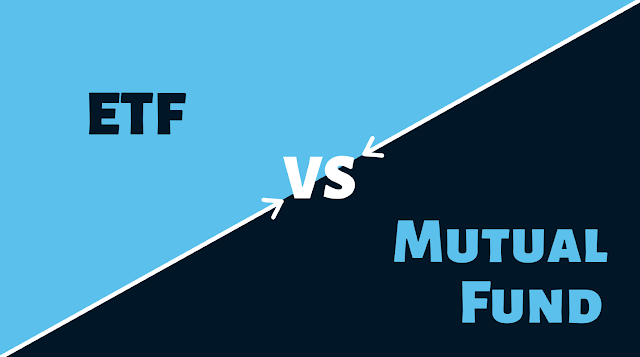Exchange Traded Funds (ETFs) and mutual funds (MFs) are two popular investment options for investors looking to diversify their portfolio. While both offer access to a wide range of assets, there are some key differences to consider when deciding which investment vehicle is right for you. In this article, we'll take a closer look at ETFs vs. MFs, and explore the pros and cons of each.
 |
| ETF vs Mutual funds Which is the Best Investment Option Short Term vs Long Term |
What are ETFs?
ETFs are investment funds that are traded on stock exchanges, just like individual stocks. ETFs hold a portfolio of underlying assets, such as stocks, bonds, or commodities, and aim to replicate the performance of a particular market index, such as the S&P 500 or the Dow Jones Industrial Average. ETFs are designed to be a low-cost, flexible investment option that offers investors exposure to a wide range of assets.
What are Mutual Funds?
Mutual funds are investment funds that are managed by a professional fund manager. Mutual funds pool money from multiple investors and invest in a diversified portfolio of assets, such as stocks, bonds, and money market instruments. Mutual funds are designed to be a long-term investment option, with a focus on generating consistent returns over time.
ETFs vs. MFs: Pros and Cons
Trading flexibility
ETFs offer greater trading flexibility than mutual funds. ETFs can be bought and sold on stock exchanges throughout the trading day, just like individual stocks. This allows investors to take advantage of market movements and make quick trades. In contrast, mutual funds are priced once per day, at the end of the trading day, which can make it harder to take advantage of short-term market fluctuations.
Expense ratios
Expense ratios are the fees that investors pay to invest in an ETF or MF. ETFs typically have lower expense ratios than mutual funds, making them a more cost-effective option for investors. The lower fees associated with ETFs can lead to better returns over time, as fees can eat into investment returns.
Minimum investment amounts
ETFs typically have lower minimum investment amounts than mutual funds. Many ETFs can be purchased with just a few hundred dollars, while mutual funds often require minimum investments of several thousand dollars. This makes ETFs a more accessible investment option for small investors.
Active vs. passive management
Mutual funds are often actively managed, which means that a professional fund manager makes investment decisions on behalf of investors. This can lead to higher fees and less transparency. In contrast, ETFs are often passively managed, which means that they track the performance of a market index, such as the S&P 500. Passive management can lead to lower fees and greater transparency.
Liquidity
ETFs are generally considered to be more liquid than mutual funds. ETFs can be bought and sold on stock exchanges throughout the trading day, which makes it easier for investors to enter and exit positions. Mutual funds, on the other hand, are priced once per day, which can make it harder for investors to exit positions quickly.
Conclusion
In conclusion, ETFs and mutual funds are two popular investment options for investors looking to diversify their portfolio. Both offer access to a wide range of assets and can be an effective way to generate long-term returns. However, there are some key differences to consider when deciding which investment vehicle is right for you. ETFs offer greater trading flexibility, lower expense ratios, lower minimum investment amounts, and passive management. Mutual funds, on the other hand, offer active management and can be a more accessible investment option for some investors. Ultimately, the decision between ETFs vs. MFs will depend on your individual investment goals and risk tolerance.
